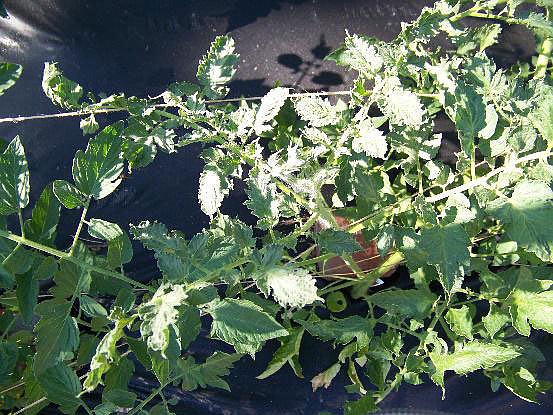Q. I have a few blueberry plants. What is a good way to keep the birds from eating the fruit?
A. Using bird netting is the most effective way. But just draping it over them may not be sufficient. Once they get a taste for the fruit, they can be unrelenting. So a frame or similar to hold the netting up and away from the plant is the only sure way.
Birds can also be scared away. Hanging up some pie tins over the plant so they twist and bang together in a breeze is a good one. There is also a number of other bird-repelling items that can be purchased, like a big yellow ball with an "eye" on it. For both the netting and any of these devices, having them in place about a week before the fruit ripens is best.
Q. The tops of some of my tomato plants are twisting up. What might it be?
A. There could be three different causes, and this can get complicated. So let's review some simple possibilities, and one would likely have to follow up with more information to confirm. The best way to follow up is with pictures. Physical samples can be brought by the Extension hours during business hours (8 a.m.-4:30 p.m.).
Some type of herbicide drift or contamination is often the culprit (see photo), the two most common being spot spraying or lawn herbicides applied nearby and a sprayer used to apply a fungicide or insecticide that previously had a weed killer in it. We advise using a herbicide sprayer dedicated to that use only; get another sprayer for these other jobs.
Another common culprit is a small insect that feeds on the developing leaves. Common pests for this are aphids, spider mites, thrips and leafhoppers. The symptoms vary with these, so we'd need to get more detail on the symptoms.
Lastly, tomatoes can get a number of viruses. Viruses are often observed on just one or two plants, and twisty top growth is one of several symptoms that can result. Often, these plants are stunted and yellowish, too. If they can be diagnosed, they should be removed because insects can spread the virus to other healthy plants, and actually, people can spread it when handling the plants.
Q. I know mulberry trees grow in the wild. Where are they from, and are there any nice types to plant?
A. The mulberry native to Missouri is commonly called red mulberry and is the species Morus rubra. It is considered a medium-sized tree, and most will produce the dark purple fruit many people enjoy. Birds really like the fruit, and both their droppings and fruits that fall off can stain. So if planted, the trees are best where they have plenty of space.
As with many wild trees that sprout up prolifically (thanks in part to the birds), little has been done with red mulberry aesthetically. The closely related species from the Orient is Morus alba, or white mulberry, and a weeping form has been developed from it (Pendula). An attribute for folks growing fruit like blueberries and cherries is mulberries serve as a "decoy tree," giving the birds something else to eat when you are protecting your crop. Red and white mulberries can cross, and one such selection has a longer fruit-bearing period; it's called "Illinois everbearing," thus a better decoy tree.
White mulberry has a notable history, serving as feed for silkworms. It was brought to this country centuries ago and was planted by settlers for the fruit, which is considered sweeter than red mulberry. White mulberry and crosses of it to red mulberry have all escaped into the wild.
The Central Missouri Master Gardeners are a volunteer group of 191 members, 122 of whom are Cole County residents, who maintain 11 beautification sites in Cole County. Master Gardeners must complete a basic training program of at least 30 hours of horticultural training including landscaping, lawns, vegetables, flowers and fruits, as well as 30 hours of volunteer service.
Have a gardening question of your own? The Central Missouri Master Gardeners hotline is staffed from 12:30-4:30 p.m. Tuesdays and Fridays; call 634-2824 then or anytime to leave a message.

